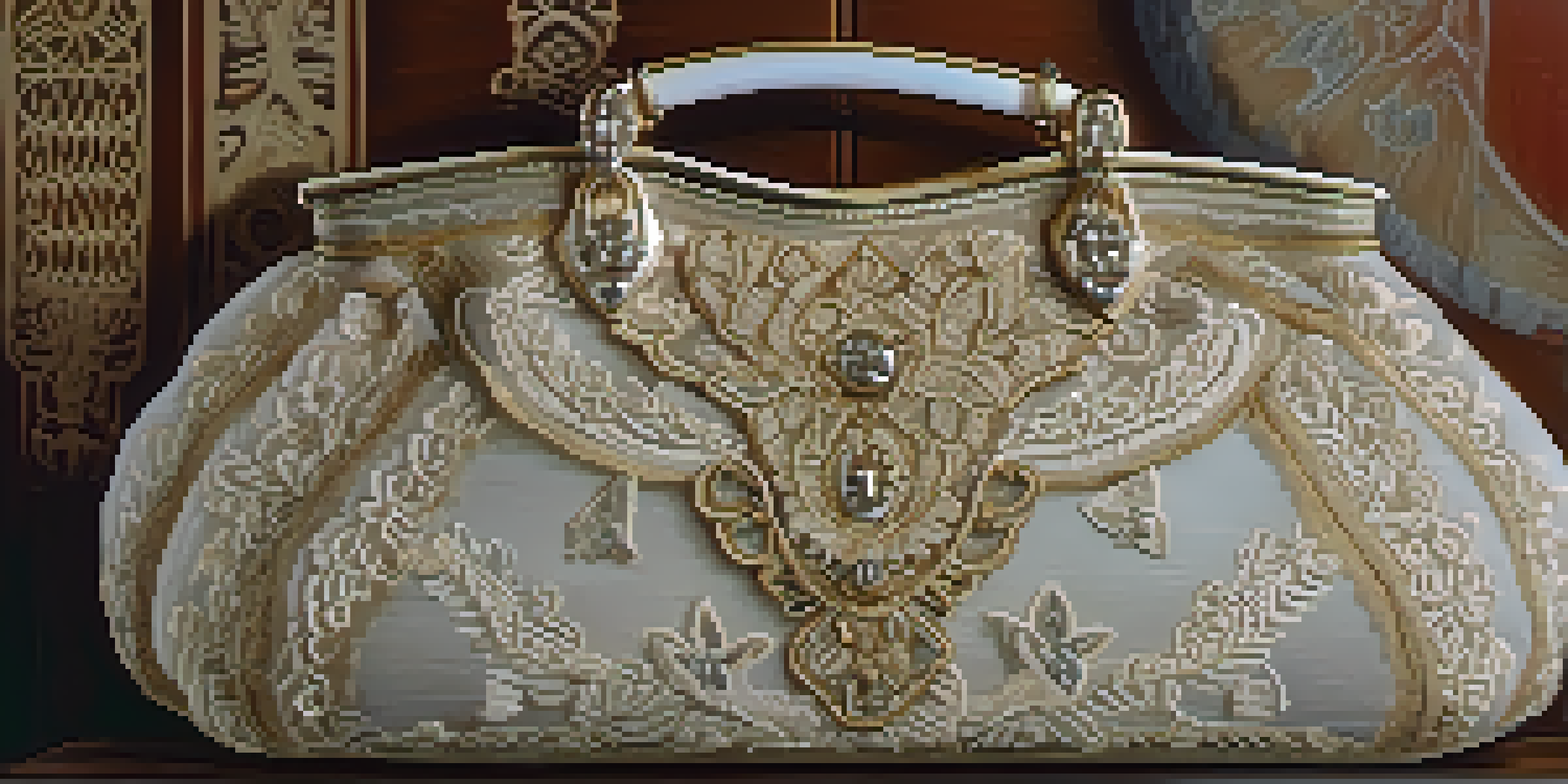Luxury Brands Embracing Cultural Heritage and Preservation

The Rise of Cultural Heritage in Luxury Branding
In recent years, luxury brands have increasingly turned to cultural heritage as a cornerstone of their identity. This shift reflects a growing consumer desire for authenticity and meaningful storytelling behind the products they purchase. Brands like Gucci and Louis Vuitton are leading the charge, weaving traditional craftsmanship and historical references into their modern offerings.
Luxury is the balance of design, quality, and craftsmanship.
By embracing their cultural roots, these brands not only enhance their image but also create a deeper connection with consumers. This strategy allows them to stand out in a saturated market filled with fast fashion alternatives. As a result, luxury brands are no longer just about exclusivity; they are also about celebrating diversity and history.
Moreover, this trend encourages a broader appreciation for cultural narratives and the artisans behind them. When luxury brands share their heritage, they foster respect and interest in traditional practices, bridging the gap between old and new. This revitalization of cultural elements ultimately enriches the luxury experience.
Examples of Luxury Brands Celebrating Heritage
Several luxury brands have successfully incorporated cultural heritage into their products, demonstrating how tradition can inform modern design. For instance, Dior's collaboration with artisans from the region of Calais highlights the craftsmanship of French lace-making, breathing new life into a centuries-old tradition. Similarly, Fendi has showcased the intricate techniques of Italian artisans, ensuring that their skills are preserved for future generations.

Another notable example is Hermès, which has long celebrated its equestrian roots through its iconic silk scarves. By drawing inspiration from historical motifs and equine culture, Hermès not only honors its heritage but also educates consumers about the brand's past. This approach transforms each product into a narrative that resonates with those who appreciate both luxury and history.
Cultural Heritage Boosts Luxury Brands
Luxury brands are increasingly integrating cultural heritage into their identity to connect with consumers seeking authenticity and meaningful storytelling.
These examples illustrate how luxury brands can successfully merge tradition with contemporary aesthetics. By doing so, they not only appeal to a discerning audience but also contribute to the preservation of cultural practices that might otherwise be forgotten.
Cultural Preservation and Sustainable Practices
Incorporating cultural heritage into luxury branding goes hand in hand with sustainable practices. Many luxury brands are now recognizing the importance of ethical sourcing and production methods that honor traditional artisanship. By collaborating with local craftspeople, these brands help sustain livelihoods while ensuring that age-old techniques remain relevant in today’s market.
Culture is the widening of the mind and of the spirit.
This commitment to sustainability enhances brand loyalty, as consumers increasingly support companies that prioritize ethical practices. Brands like Stella McCartney and Patagonia have set the standard by championing environmentally friendly approaches, and the luxury sector is following suit. By integrating cultural preservation with sustainability, luxury brands appeal to the socially conscious consumer.
Moreover, this synergy fosters a sense of community and respect for diverse cultures. It encourages consumers to appreciate the stories behind the products they buy, making each purchase feel like a contribution to cultural preservation rather than merely a transaction.
The Role of Storytelling in Luxury Marketing
Storytelling is a powerful tool that luxury brands utilize to convey their commitment to cultural heritage. By sharing the narratives behind their products, brands can engage consumers on a deeper emotional level. A well-crafted story not only elevates the product but also captivates the audience's imagination, transforming a simple purchase into a cherished experience.
For example, brands like Burberry often share stories about their iconic trench coats, detailing their historical significance during wartime. This adds layers of meaning and emotional value to the product, encouraging buyers to connect with its legacy. Such storytelling is a vital part of marketing strategies in the luxury sector.
Sustainability and Ethical Practices
Many luxury brands are recognizing the importance of sustainable practices and ethical sourcing, which aligns with consumer demand for social responsibility.
Ultimately, storytelling enables brands to position themselves as custodians of culture and history. The more compelling the narrative, the more likely consumers are to feel aligned with the brand’s values, fostering a sense of loyalty and community.
Consumer Demand for Authenticity and Identity
Today's consumers are increasingly seeking authenticity in the brands they support. This trend is particularly evident in the luxury sector, where buyers want to feel a personal connection to the products they purchase. As a result, luxury brands are responding by highlighting their cultural heritage and the craftsmanship that goes into each item.
This demand for authenticity also reflects a broader societal shift toward valuing individuality and personal expression. Luxury consumers are looking for pieces that not only represent status but also tell a unique story about their identity. By embracing their cultural roots, brands can cater to this desire, providing customers with items that resonate on a personal level.
Additionally, this pursuit of authenticity encourages consumers to explore and celebrate diverse cultures. It empowers them to make informed choices about the products they buy, fostering a deeper appreciation for the craftsmanship and heritage behind luxury goods.
Challenges in Balancing Heritage and Modern Trends
While the integration of cultural heritage into luxury branding is largely positive, it does come with challenges. One significant issue is the risk of cultural appropriation, where brands borrow elements from cultures without proper acknowledgment or respect. This can lead to backlash from communities who feel their heritage is being exploited for profit.
Luxury brands must navigate these waters carefully, ensuring they engage with cultural symbols and practices in a respectful manner. Collaborating with local artisans and communities can help mitigate these risks, fostering genuine connections and mutual respect. It’s essential for brands to prioritize authenticity over mere aesthetic appeal.
Storytelling Enhances Consumer Appeal
Effective storytelling in luxury marketing elevates products by creating emotional connections and highlighting the cultural narratives behind them.
Additionally, balancing tradition with modern trends can be tricky. Brands need to innovate while still honoring their heritage, striking a delicate balance to appeal to a contemporary audience. Successfully navigating these challenges can lead to a richer, more meaningful luxury experience.
The Future of Luxury Brands and Cultural Heritage
Looking ahead, the landscape of luxury branding will likely continue to evolve as cultural heritage becomes increasingly central to brand identity. As consumers become more aware of global issues, including sustainability and cultural preservation, luxury brands will need to adapt to these changing expectations. This evolution presents an opportunity for brands to rethink their narratives and practices.
Future luxury brands may embrace innovative approaches to showcasing cultural heritage, such as immersive experiences or digital storytelling. This could involve virtual reality tours of artisan workshops or interactive online platforms that allow consumers to learn about the history behind their products. Such initiatives could deepen consumer engagement and foster a greater appreciation for cultural heritage.

Ultimately, the successful luxury brands of the future will be those that prioritize authenticity, storytelling, and sustainable practices while remaining rooted in their cultural heritage. By doing so, they can create a lasting impact that resonates with consumers and honors the traditions they represent.